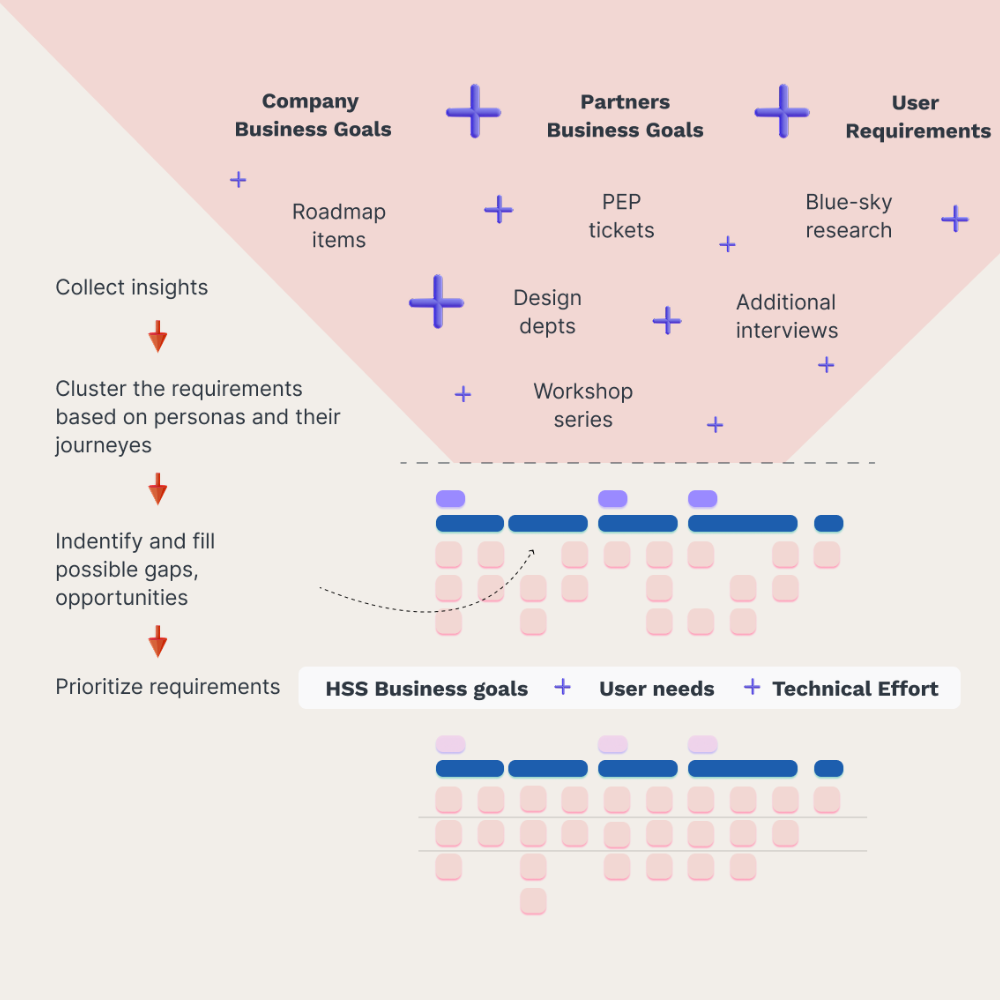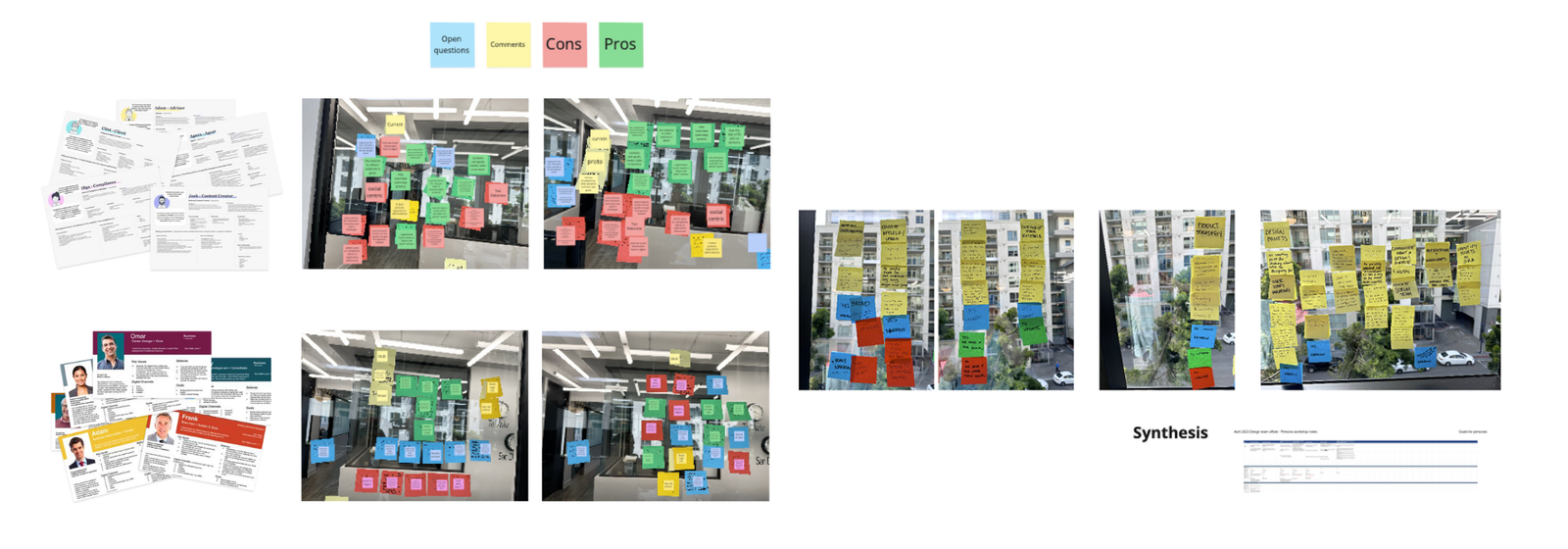Zero-to-Persona
Persona building
Summary: This case study documents a successful, multi-year initiative to redefine user understanding at Hearsay. The process began with building new proto-personas for key user roles through user interviews and user story mapping. This foundational work revealed a new user segment and enabled the creation of a shared knowledge. The project was not a one-time task: it evolved. The lessons learned were directly applied in my next role, demonstrating a powerful, repeatable methodology for establishing a user-centric foundation.
My Role: I, as a product designer had to own and lead the persona-building initiative. I was responsible for the end-to-end process, from planning to promoting the adoption of the final deliverables. My contribution extended beyond design, as I also facilitated communication and alignment across the organization.
Team: I worked with product and engineering managers, but mostly with senior designers and researchers. We collaborated closely with cross-functional teams to champion and execute this project, collectively moving towards the vision.
History of Evolution
When I started my journey at Hearsay as a trainee, the world was in a state of rapid change. The pandemic had accelerated the shift to a digital-first society, and the demand for our products was skyrocketing. Our mission was to empower financial advisors and insurance agents to thrive in this new landscape, but we were working with a significant handicap: our understanding of our users was outdated and incomplete.
The existing so-called personas were legacy marketing artifacts from 2017, and vital user types were entirely missing. We knew we had to help our users navigate this digital shift, especially those who weren’t experts in online presence, but without a clear foundation, our wonderful vision was just that: a vision.
My mentor and I championed the project to create a new set of role-based personas, providing a shared understanding of users and a reliable foundation for product development. Following the kickoff, I stepped up to own the initiative – little did I know, that I end up managing the Social persona work for the next two years. When our team went to a design offsite in San Diego, I proposed enhancing the personas as a key topic, setting the stage for a deeper, more impactful process.

Marketing Personas
2017

Role-based Proto-Personas
2022

Social Persona Enhancement
2024
Building the Proto-Personas
With that, my core challenge was to lead a project that would establish a new, robust, and shared understanding of our users: a user-centric foundation that the entire EPD organization could rely on. My process was a deep dive into user behavior and motivation, shaped by a lean, agile methodology and close collaboration with senior designers and cross-functional teams.
Research
The project’s progress was far from linear. It was a complex, iterative process, much like assembling a puzzle with similar yet distinct pieces. To ensure a cohesive solution and avoid significant gaps, I continuously moved back and forth between research approaches, findings, and improvements, always planning ahead… at least, tried my best.
User Interviews
During the qualitative interviews, I gathered fresh insights into our users’ roles, motivations, and pain points. These interviews revealed a user segment we hadn’t previously identified: a specific type of Admin user. This discovery was a significant finding that highlighted the need for a more comprehensive understanding of our entire user base.
User Story Mapping
I led user story mapping sessions, to uncover user JTBD (job to be done), pain points and workflows. This emotional depth helped our teams understand not just what our users did, but why they did it.
Why User-Story Mapping?
1. Support business at decision making by:
- Identify gaps in the user journey and highlight possible business opportunities
- Makes visible touchpoints between business areas
- Makes the planning more efficient and transparent for everyone (helps to create and sort out roadmap items)
2. User-story maps support the success of Agile product-development teams for several reasons:
- Improved collaboration and team alignment.
- Facilitating the creation and expansion of the product backlog.
- Product slicing and well-informed clear prioritization.
- Support identification of risky assumptions.
Persona Workshops & Critique
I facilitated workshops to define five key proto-personas based on user roles: Agnes (Agent), Adam (Advisor), Clint (Client), Olga (Compliance), and Josh (Content Creator). To validate these, we held a design critique session where stakeholders reviewed the personas and marked points as Important, Misleading, Incorrect, or Missing data. This ensured our personas were accurate and comprehensive.

Integration and Adoption
With our validated and refined personas, the story wound down into a period of integration. The most rewarding part of this project was bringing these personas to life for the entire company. My job was to ensure these insights weren’t just a document but were actively used.
I organized and facilitated workshops with product and engineering teams to present our findings in a clear, interactive way. I created visual maps that illustrated the relationship between our user groups and how content flowed through the system, from creation to compliance to publication.
The result of this effort was a set of personas that the organization embraced. As a step towards adoption, our Product leader printed the personas and placed these papers on desks in the San Francisco office, serving as a constant, tangible reminder of our user-centric mission.
However, the personas were still far from perfect. Key areas for improvement included:
- going beyond roles
- not enough informations
- outdated information especially on the admins


Enhancement
Months went by and these personas shaped. One day one of our research revealed that existing personas didn’t highlight the crucial differences in how Agents and Advisors operate. For instance, an Agent’s career often starts with prospecting within their social circle before moving to advertising, whereas an Advisor’s work is heavily regulated, and they focus on referrals for new clients. This was the “aha!” moment that justified our entire approach.
In 2024, our team revisited the persona initiative to create a more nuanced and dynamic framework for understanding our users. My team and I led the effort to enhance our existing personas by integrating insights on their digital presence maturity and company size. This initiative culminated in a dedicated, full-day workshop at our design offsite in San Diego, where we aligned our entire team on this new, more sophisticated understanding of our users.



The Impact
This project’s success wasn’t just in creating a documents that got used actively, it was in embedding user-centered thinking into our company culture. The personas became a fundamental tool that every team, from product to engineering, used to communicate, and guide their decisions.
- The personas established a clear, reliable baseline for understanding our users, which enabled teams to make faster, more confident, and user-centric decisions.
- The long-term progress of persona building laid the groundwork for the research team next major initiative: the Motivation and Guidance Research, where I supported the team to further explore user behavior and content creation. This research already zoomed into specific topics such as usage of mobile, AI, SEO and more.
Reflections
Having built these personas at Hearsay, I was able to apply the same process in my next role at Yext. When a newly created product’s team lacked personas, my team and I started by defining three user mindsets and then built out the main personas from there, establishing a new user-centric foundation.
This project reinforced the power of research-driven approach and showed me that understanding your users is an ongoing process, not a one-time task. It’s what I loved about being at one company: not only having the domain knowledge but also having the chance to continuously learn and refine our understanding of our users, ensuring we never get lost in a “rabbit hole” of assumptions.